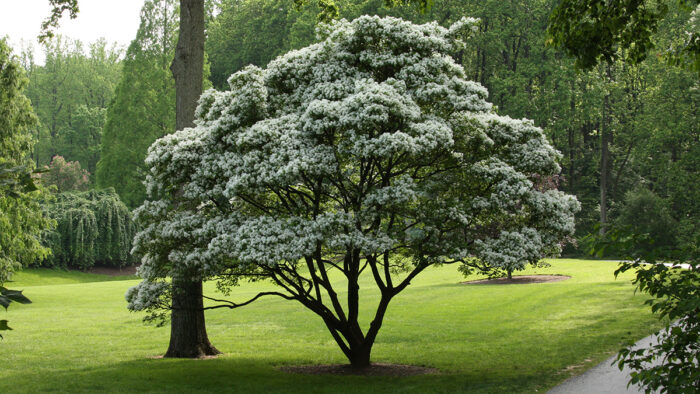
I recently drove through a new subdivision in my city. Every new house came with a brand-new tree in the front yard. The contractor special everyone got was a repeat of two or three cultivars first popular during the Reagan administration. I’m not saying these were all bad plants. What bothered me was how unoriginal they were.
In a suburban setting, having a tree that catches your neighbors’ eyes can be a boost to your gardening ego. Beyond aesthetics, having a diversity of plants in a neighborhood can be a great defense against pest and disease problems that are easily spread through a monoculture of trees. The following is a list of small to medium-size trees that are perfect for a typical front or back yard in the Southeast. These selections should be relatively commercially available and help your yard stand out from the crowd.

Sweetbay magnolia is a charming, fast-growing native with a long season of bloom
Magnolia virginiana, Zones 5–10
This native magnolia is still relatively uncommon in residential landscapes but makes a great choice for the Southeast. It has semi-evergreen foliage and is great for providing shade. Additionally, there are cultivars with leaves that are more evergreen and ones that have improved hardiness. These cultivars include Moonglow® (‘Jim Wilson’), ‘Henry Hicks’, ‘Green Shadow’, and Green Mile™ (‘MVHH’). Swamp magnolia (Magnolia virginiana var. australis, Zones 5–10), which is a naturally occurring variety that is more southern in its native range, is more treelike in appearance than the straight species. Whichever sweetbay magnolia you choose, you won’t be disappointed. The growth rate of young trees is impressive; they eventually reach 25 feet tall and wide in full sun to partial shade. This species is one of the best choices for a small native tree where shade is needed rather quickly. Cup-shaped, sweetly scented blooms appear in spring and continue blooming sporadically through the growing season.

Fringe tree species are trouble free and have very showy blooms
Chionanthus spp. and cvs., Zones 4–9
Fringe trees have creamy, fragrant white flowers that are suspended from their branches in spring. The common name points to these delicate flowers, which feature airy, fringelike, creamy white petals. If you choose Chinese fringe tree (Chionanthus retusus, Zones 5–9) or our native white fringe tree (Chionanthus virginicus, Zones 4–9), which are the most commercially available species, you will be pleased with the results. These species are large shrubs to small trees that thrive in full sun and well-drained soil and will grow roughly 20 feet tall and wide in time. They are quite adaptable to drought after establishment. Overall, these are slower growers, but their ability to flower profusely even at a young age makes them real winners.

Persian ironwood has attractive bark and glossy foliage
Parrotia persica, Zones 5–8
Persian ironwood is often overlooked for use in the landscape but is finally being promoted more often by savvy nursery owners. This is a tree that brings true four-season interest to the table. Attractive new growth in the spring gives way to dark green leaves in the summer. A variety of fall colors can be displayed on Persian ironwood depending on plant genetics, weather, and soil type. Its attractive, colorful bark is notable year-round. This small tree’s habit tends to be low-branching, and the bark will exfoliate with age. In a Southeastern landscape you can expect this tree to get around 20 feet tall and wide if sited in full sun to partial shade.

Japanese crape myrtle has the best bark of any crape myrtle
Lagerstroemia subcostata var. fauriei, Zones 7–9
It’s hard to keep up with all the new cultivars of crape myrtle that have entered the marketplace over the last 10 years. The promotion of newer, small selections has made the plants of this genus available to almost anyone in the Southeast with a sunny spot in their yard. However, one of the best crape myrtle selections continues to be overlooked by many, particularly by those in warmer parts of the Southeast. We owe the emergence of the Japanese crape myrtle to the U.S. National Arboretum, which introduced this plant in the 1950s. In contrast to the more common crape myrtle (Lagerstroemia indica, Zones 6–9), this plant’s main standout feature is its dark red-brown bark. The overall flower-power impact of Japanese crape myrtle is not as impressive or as diverse as some other species and hybrids, but its beautiful bark and vaselike habit more than make up for this shortcoming. Japanese crape myrtle will grow about 30 feet tall and 20 feet wide and prefers full sun. For information on pruning, check out Pruning Crape Myrtles in the Southeast.
For more recommendations of top-performing deciduous trees, check out:
- Trees That Always Please
- A Dogwood Quartet for the Southeast
- Spring-Blooming Magnolias for the Southeast
And for more Southeast regional reports, click here.
—Andy Pulte is a faculty member in the plant sciences department at the University of Tennessee.
Fine Gardening Recommended Products

DeWalt Variable-Speed Cordless Reciprocating Saw

DeWalt Variable-Speed Cordless Reciprocating Saw with 6-Piece Saw Blade Set


















Comments
Log in or create an account to post a comment.
Sign up Log in